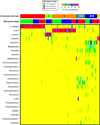Association between the vaginal microbiota, menopause status, and signs of vulvovaginal atrophy
- PMID: 24080849
- PMCID: PMC3994184
- DOI: 10.1097/GME.0b013e3182a4690b
Association between the vaginal microbiota, menopause status, and signs of vulvovaginal atrophy
Abstract
Objective: The vaginal microbiota helps protect the female genital tract from disease. We sought to describe the composition of the vaginal microbiota in premenopausal, perimenopausal, and postmenopausal women and to explore the association between the microbiota and vulvovaginal atrophy (VVA).
Methods: Eighty-seven women (aged 35-60 y) were classified as premenopausal (n = 30), perimenopausal (n = 29), or postmenopausal (n = 28) according to Stages of Reproductive Aging Workshop guidelines. Midvaginal bacterial community composition was characterized by 16S ribosomal RNA gene analysis.
Results: Bacterial communities clustered into six community state types (CSTs), of which four were dominated by Lactobacillus crispatus, Lactobacillus gasseri, Lactobacillus iners, or Lactobacillus jensenii, and two (CST IV-A and CST IV-B) had low relative abundance of Lactobacillus. CST IV-A was characterized by Streptococcus and Prevotella, whereas CST IV-B was characterized by Atopobium. There were significant associations between menopause stage and CST (P = 0.004) and between VVA and CST (P = 0.002). Perimenopausal women were more likely to be classified as CST IV-A or L. gasseri CST, whereas postmenopausal women were often classified as CST IV-A. CSTs dominated by L. crispatus and L. iners were more prevalent in premenopausal women. Nineteen participants had signs of mild or moderate VVA. Compared with women with no VVA, the vaginal microbiota of women with mild or moderate atrophy had 25-fold greater odds of being classified as CST IV-A versus L. crispatus CST (adjusted odds ratio, 25.89; 95% credible interval, 2.98-406.79).
Conclusions: A distinct bacterial community state (CST IV-A) with a low relative abundance of Lactobacillus is associated with VVA. Future studies recruiting a larger number of women are needed to replicate the findings. This study provides an impetus for future longitudinal studies designed to manage, modulate, and restore vaginal microbiota homeostasis, which would provide stronger evidence for a causal relationship with VVA and ultimately improve the treatment and prevention of atrophic vaginitis in menopause.
Conflict of interest statement
Figures


Republished in
-
Association between the vaginal microbiota, menopause status, and signs of vulvovaginal atrophy.Menopause. 2018 Nov;25(11):1321-1330. doi: 10.1097/GME.0000000000001236. Menopause. 2018. PMID: 30358729
Comment in
-
Vagina dialogues.Menopause. 2014 May;21(5):437-8. doi: 10.1097/GME.0000000000000224. Menopause. 2014. PMID: 24594865 Free PMC article. No abstract available.
References
-
- Simon JA, Reape KZ. Understanding the menopausal experiences of professional women. Menopause. 2009;16(1):73–76. - PubMed
-
- Sturdee DW, Panay N. Recommendations for the management of postmenopausal vaginal atrophy. Climacteric. 2010;13(6):509–522. - PubMed
-
- Nappi RE, Kokot-Kierepa M. Vaginal Health: Insights, Views & Attitudes (VIVA) - results from an international survey. Climacteric : the journal of the International Menopause Society. 2012;15(1):36–44. [Research Support, Non-U.S. Gov't] - PubMed
-
- Tan O, Bradshaw K, Carr BR. Management of vulvovaginal atrophy-related sexual dysfunction in postmenopausal women: an up-to-date review. Menopause. 2012;19(1):109–117. [Review] - PubMed
Publication types
MeSH terms
Substances
Associated data
Grants and funding
LinkOut - more resources
Full Text Sources
Other Literature Sources
Medical

